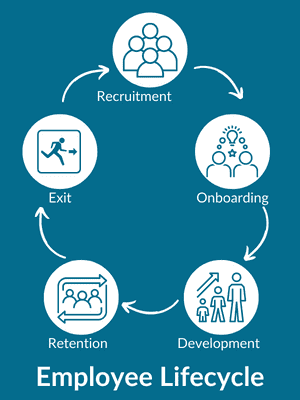All employees go through different stages with a company – this is known as the employee lifecycle. From when a candidate applies for a job to when an employee hands in their resignation. The employee lifecycle illustrates the various stages an employee will go through during their time with a company. It helps HR leaders measure employee engagement levels and staff turnover rates. Management can use the employee life cycle to track employees throughout the different stages of their career with the company and see which areas they can improve on in order to retain staff.
The employee lifecycle consists of 5 stages:
- Recruitment
- Onboarding
- Development
- Retention
- Exit

Let’s take a closer look at each stage.
1. Recruitment:
This stage is all about getting the right applicants to fill the open positions within the company. It incorporates all the steps leading up to and hiring a new employee. For example, attracting candidates to apply for a role. A lot of work is involved in attracting good talent to your business and companies need to invest in an effective recruitment strategy.
As well as that your recruitment strategy is the first glimpse a potential employee will get of your business. When a candidate has a negative recruitment experience it impacts their opinion of the company going forward, no matter if they get hired or not. That’s why you should ensure the recruitment process is as efficient as possible – you’re not making possible candidates wait for a long time without hearing any updates or calling them in for too many interviews. The process should be as easy as possible and give a good first impression of the business.
2. Onboarding:
You’ve found the correct person, now you need to equip them with the correct information and tools to work efficiently. The employee needs the correct resources so they feel welcomed into the organization and fit well into the company culture. During this stage of the employee lifecycle, employees will learn about the company policies, and procedures and start any training needed for the job. A good onboarding process actually goes a long way; in fact, 69% of employees are more likely to stay with a company for over 3 years if they experienced a good onboarding process. So don’t underestimate the power of onboarding!
3. Development

When the employee gets up and running and starts doing some real work they move into the development stage. This is where they put their learning into practice and management gives feedback on their work. Development is hugely important to an employee and management needs to be engaged during this stage. For example, through one-on-ones, performance reviews, and catch-up meetings. Management can use this stage to learn more about what motivates a worker and how they can improve engagement with the role.
4. Retention
Now that your employee is doing real work and is well integrated into the company, you need to hold on to them. This is what is known as the retention stage. You need to still work on developing their skills and recognizing their hard work in order to keep them engaged. Training and upskilling opportunities are a great way to keep employees engaged and hang on to your best talent.
5. Exit
The final stage of the employee lifecycle. This is where the employee leaves the company as they find a new job, retire, get fired, or leave for other personal reasons. It is an important stage as well and HR leaders should conduct exit interviews and other feedback methods to understand the real reason an employee leaves. HR can also use employee retention surveys to dive deeper and improve the retention rate of the business. Another important thing to remember is how an employee leaving will impact their colleagues. You need to have a plan in place so the remaining workers don’t’ feel overwhelmed with the extra work they may have.
Why is the employee lifecycle so important?
The employee lifecycle allows HR leaders to follow employees through their time with a company in a consistent way. Each stage along the cycle can be analyzed so management can see which stage the company is doing well or not. For example, if a lot of employees seem to be leaving the company during the retention stage, the business should look at how they can keep them engaged with new training opportunities or new work projects.
Benefits of the employee life cycle
- Build strong relationships between employees and management: When management shows an invested interest in developing the skills of employees, they will notice. Employees will feel valued in their role and be appreciative of the opportunities for growth.
- Skill development: Providing upskilling opportunities builds a stronger and more productive workforce. Your teams are learning and constantly improving and can use the skills learned in their day-to-day tasks.
- Improve staff turnover: As we’ve previously said keeping employees engaged is proven to improve employee retention.
- Recruitment of high-quality talent: When your company has a good reputation more high-quality workers in the job market will want to work there. By investing in your workforce you are making your company a more attractive place to work!
Take a look at your own company’s employee life cycle. What stages do you have trouble with? Recruiting good talent? Retaining existing employees? Following an employee life cycle makes it easier to be able to put strategies in place to improve all these areas.





